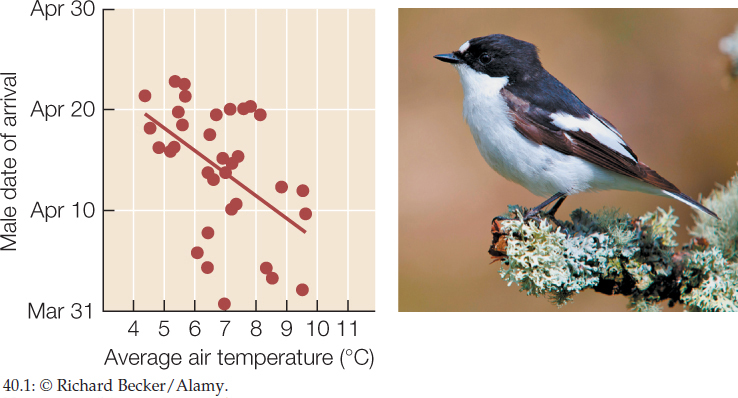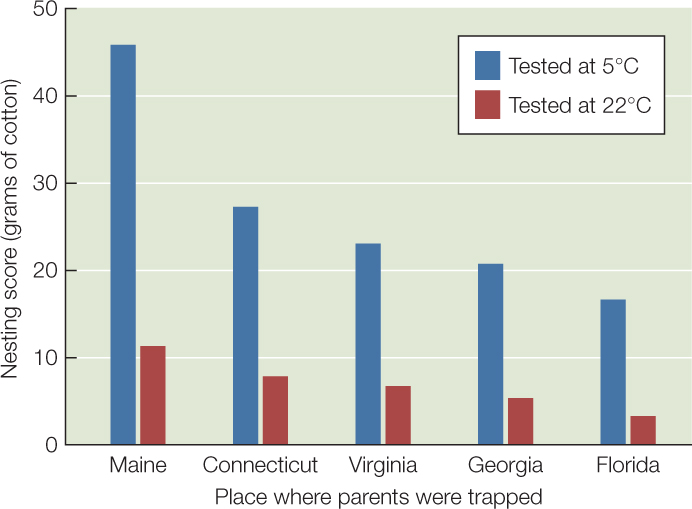CONCEPT40.1 Behavior Is Controlled by the Nervous System but Is Not Necessarily Deterministic
Animals are distinctive in that behaviors play central roles in their interactions with each other and with their environments. They can rapidly approach each other, flee from each other, vocalize, seek shelter, and migrate—all by using their muscles. Of all animal characteristics, adjustments of behavior are often the most visible responses to environmental change. Today, for example, many migratory animals are changing the timing of their migrations in response to climate change (FIGURE 40.1). Behavioral shifts of populations into new habitats closer to the poles may be the greatest hope of many to survive if conditions where they currently live become too warm.

LINK
The effects of climate change on ecosystems and communities are complex, and changes in the behavior of a species may not be sufficient to ensure its survival; see Concept 45.5
When an animal engages in behaviors, biologists today agree that the animal’s nervous system activates and coordinates the behaviors. When lizards run, for instance, neurons stimulate their leg motions. Similarly, when people take part in animated conversations, their brains activate their hand movements and facial expressions. According to this viewpoint, although behaviors—such as leg motions and smiles—are fleeting and not in themselves material objects, they have a material basis: they arise from brain tissue, neurons, and the movements of ions that give rise to nerve impulses (see Concept 34.2).
Many types of evidence point to the neural basis of behavior
We know that particular types of human behavior depend on the function of particular brain regions. For example, if the part of a person’s brain known as Broca’s area (see Figure 34.26B) is badly damaged by accident or disease, the person may be perfectly fine in almost all ways but will have extreme difficulty with talking or writing. This sort of “negative” evidence (what goes wrong when a brain region is missing?) is complemented by positive evidence from brain-imaging studies in normal people. As seen in Figure 34.27, when a person speaks, specific brain regions show evidence of increased metabolism. These types of evidence point to a neural basis for complex behaviors involved in human communication.
Additional evidence for the neural basis of behavior comes from a very different source: the study of certain highly stereotyped animal behaviors, often called fixed action patterns, which are expressed by animals without prior learning and are often resistant to modification by learning. These behaviors point to control by the nervous system because they are sometimes elaborate and yet they depend solely on the simple presence of a healthy nervous system to be performed. A classic example is the begging behavior of gull chicks. In some species of gulls, adults have a red dot on their bills. The chicks, in a fixed action pattern, peck at the red dot when a parent returns to the nest from foraging, and this pecking stimulates the parent to regurgitate food. Pecking at a red dot is so stereotyped that newly hatched, naive gull chicks peck at models of gull heads with a red dot (although they respond only slightly to models without a dot) and even at red-dotted models of a beak without a head (FIGURE 40.2). Web spinning by some spiders is another example of a highly stereotyped, unlearned behavior. The spinning of a web involves hundreds or thousands of movements performed in sequence, and each time a spider builds a web, the sequence is largely the same. Yet in many species there is no opportunity for a spider to learn how to build a web from another spider because the adults die before their eggs hatch.

829
Behaviors evolve
Recognizing that neural tissue gives rise to behaviors, we can expect behaviors to evolve. As is true of all tissues, the properties of neural tissue are in part encoded by genes, which are mutable and passed from generation to generation. If certain gene variants, or alleles, produce more adaptive behaviors than others, natural selection can favor those alleles. In this way the frequencies of alleles in a population can change so that the properties of the neural tissue—and the behaviors coded by the tissue—adaptively evolve.
Many studies establish that genes can exert important effects on behavior. Perhaps the most graphic evidence comes from studies of mutants in fruit flies (Drosophila). One of the most important examples involves mutations in a fruit fly gene named per (for period). (We now know that mammals have homologs of this same gene.) Around 1970, Seymour Benzer and his colleagues reported mutations in this gene that radically altered the flies’ daily rhythm of activity under control of the circadian clock. To investigate these mutant flies, the investigators studied them in constant darkness, where their alternating periods of inactivity and activity were timed by their circadian clock, not by observations of day and night. In flies with ordinary, non-mutant per genes, each episode of activity started about 24 hours after the previous episode. One of the mutant alleles of per caused episodes of activity to be only about 19 hours apart. Another caused them to be about 29 hours apart. Studies of per thus demonstrated that single gene mutations sometimes alter behavior.
LINK
You can review the properties of circadian clocks in Concept 29.6
House mice (Mus musculus) in North America provide an elegant illustration of adaptive evolution of behavior in free-living wild populations. House mice did not live in North America prior to European colonization. They arrived as stowaways on European ships, presumably in random groups. Carol Lynch trapped wild house mice at five locations, from warm Florida to cold Maine. Within the mice from each location, she then paired males and females in her lab to obtain lab-born, lab-reared offspring, which she studied. All the mice studied had been born and grew up in exactly the same lab environment. When Lynch measured the nests they made, she found a trend: under identical conditions, the mice from progressively more northern populations tended to build bigger (and thus warmer) nests (FIGURE 40.3). This result points to the evolution by natural selection of a genetically controlled, behavioral propensity to build bigger nests in wild mouse populations that settled in locations where big nests are particularly advantageous.

Current studies with artificial selection indicate that behavior can evolve remarkably rapidly. In artificial selection (as opposed to natural selection), human researchers choose which combinations of animals have the most offspring, mimicking natural selection but in a highly controlled way. In one such experiment, researchers gave each mouse in a large population a running wheel and then monitored the number of revolutions each mouse voluntarily ran per day. Males that ran the highest numbers of revolutions were then mated with females that ran the highest numbers to produce a new generation of mice. When those mice grew to adulthood, they were put through the same process. This selection procedure was repeated generation after generation. After only 13 generations, the selected mice on average ran 12.1 kilometers per day, more than twice as far as control mice (5.5 kilometers per day). Primarily, the difference reflected faster running by the selected mice, rather than a longer time spent running. Studies revealed critical changes in the brains of the selected mice, indicating that a difference had evolved in the neural control of running behavior.
Despite its neural basis, behavior is not necessarily simplistically deterministic
Earlier we noted that behaviors are often fleeting and not in themselves material objects, but they have a material basis because they arise from neural tissue. Regarding human behavior, this dichotomy—nonmaterial behavior arising from material substance—attracts the attention of virtually all branches of scholarship. Biologists, psychologists, anthropologists, sociologists, theologians, and criminologists are all concerned with the dichotomy and ponder it.
Ever since the modern study of biology began, some scientists have argued for biological determinism. Determinism, as applied to behavior, means that the behaviors of animals are hard-wired by genetics. In this view, an individual’s genes orchestrate his or her neural properties in fixed ways that in turn affect his or her behavior in fixed ways, leading to predictable behaviors. Also, in this view populations of individuals, such as different racial groups, can differ genetically in ways that produce inflexible and predictable differences in behavior among the populations.
Almost all biologists are convinced that some simple animals exhibit determinism. Clams, for example, are inflexible in many of their responses to their environment. Here, however, we focus on animals with advanced nervous systems. In particular, we focus on people.
830
Belief in human biological determinism flourished among some biologists in the nineteenth and early twentieth centuries. For example, at that time some prominent biologists believed (incorrectly) that a person’s intelligence is determined by his or her inherited brain size. According to this discarded view, the mental capacities of racial groups could be predicted by measuring relative brain sizes. In the mid-twentieth century, the Second World War and the slaughter of people in gas chambers—based on a theory of genetic inferiority—greatly reduced enthusiasm for the biological determinist view of human behavior. Later, people who argue for the deterministic view became more vocal as the twentieth century drew to a close, a trend that has continued into the twenty-first century.
Students of biology need to be aware of the two sides in this debate. Arguments for and against determinism are too important to be lost in a fog. Many arguments for determinism found in books and magazine articles marketed to the general public are not well supported by objective, statistically supported, and relevant data of the sort required for ideas to be deemed scientific.
In what ways could the behavior of animals with advanced nervous systems not be simplistically deterministic despite its neural origins? Behavior is dramatically more flexible than any other biological trait. This is true in part because learning modifies behavior. In addition, recent discoveries (which we will shortly discuss) point to important epigenetic effects on behavior. These are non-genomic effects that can exert lifelong influences and may be transmissible from one generation to the next (see Concept 11.3). As animals develop and live their lives, each individual can interact in unique ways with its environment, and—because of learning and epigenetic effects—these interactions can result in dramatic behavioral differences among genetically similar individuals.
The greatest unresolved question in all of biology is probably the question of how the human mind emerges from the human brain. The unresolved nature of this question, despite its profound importance, emphasizes that scientists have much to learn about mental phenomena and the behaviors they unleash.
CHECKpointCONCEPT40.1
- What physical objects provide the basis for animal behaviors?
- When a male robin is in reproductive condition, it has bright red breast feathers and will aggressively attack other male robins. It will also attack a simple tuft of red feathers on a stick. How does this seemingly maladaptive behavior relate to the concept of a fixed action pattern?
- Considering behaviors classified as fixed action patterns, in what way are they passed from one generation of a species to the next?
- How do experiments on artificial selection of wheel running in mice provide insight into the rate of evolution?
We have already noted that development and learning often affect an animal’s behavior. Now we will focus on these important processes.